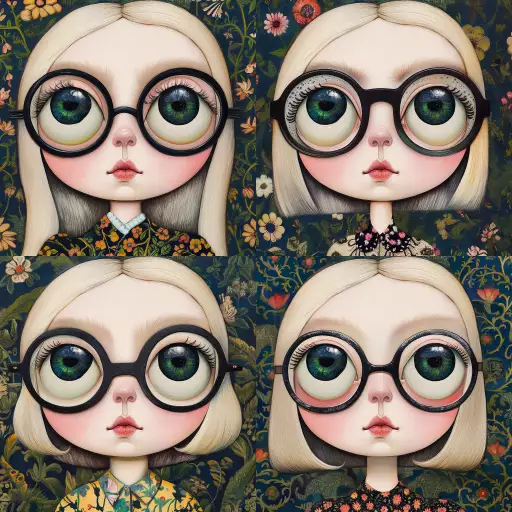Explore the Best AI Image Gallery

Pixels on Skin: Exploring the Impact of AI-Generated Images in Art
The art world is experiencing a seismic shift with the advent of AI-generated imagery. Algorithms capable of producing stunningly realistic and imaginative visuals are blurring the lines between human creativity and machine intelligence. This groundbreaking technology presents both exciting opportunities and complex challenges, prompting us to reimagine the very definition of art and its creation.
A Canvas Unbound: The Potential Uses of AI-Generated Images
AI image generation tools offer a vast array of applications that are reshaping artistic practices across diverse disciplines:
- Concept Art and Visualization: Artists can leverage AI to rapidly generate visual concepts for films, games, and other media, exploring different aesthetics and iterations before committing to final designs.
- Personalized Artwork: Imagine creating unique pieces tailored to your preferences, whether its a portrait in a specific style or a landscape reflecting a cherished memory. AI can personalize art experiences, making them more engaging and meaningful.
- Interactive Art Installations: AI-generated imagery can be integrated into immersive installations, responding to viewer input or environmental changes, creating dynamic and ever-evolving artworks.
Navigating the Ethical Landscape
While the potential of AI-generated images is undeniable, its crucial to address the ethical considerations that accompany this technology:
- Copyright and Ownership: When an AI generates an image, who owns the copyright? Is it the creator of the AI algorithm, the user who provides the input, or the AI itself?
- Bias and Representation: AI models are trained on vast datasets, which can inadvertently perpetuate existing biases in society. Its essential to ensure that AI-generated images reflect diversity and avoid reinforcing harmful stereotypes.
- Authenticity and Deception: The ability to create hyperrealistic images raises concerns about the potential for manipulation and misinformation. Distinguishing between genuine and AI-generated content becomes increasingly challenging.
The Future of Art: A Collaborative Evolution
AI-generated imagery is not intended to replace human artists but rather to augment their creative capabilities. The future likely holds a collaborative landscape where humans and AI work in tandem, leveraging each others strengths:
- Enhanced Creativity: AI can act as a brainstorming tool, generating novel ideas and pushing artistic boundaries beyond what might be conceived individually.
- Efficiency and Accessibility: AI can automate repetitive tasks, freeing up artists to focus on higher-level creative endeavors. Moreover, AI-powered tools can democratize art creation, making it more accessible to individuals with limited resources or technical expertise.
- New Artistic Mediums: AI will continue to inspire the development of innovative art forms that transcend traditional mediums. Imagine sculptures sculpted by algorithms, interactive paintings that respond to sound, or virtual reality experiences powered by AI-generated imagery.
The integration of AI into the art world is a journey of continuous exploration and adaptation. By embracing its possibilities while addressing its ethical implications, we can unlock a future where technology and creativity converge to create truly groundbreaking artistic experiences.


](https://images.ai-img.art/thumbnails/150/9d51c5e673b4f2068b7b01abc35425a06f173b76303adf9ad29ca14302c25b18.webp)


![**Representation: A teenager smiling while thinking about a friendly dog, a comic-style thought bubble with a friendly dog inside. Graphic style: Line drawing, cartoon style, influenced by Franco-Belgian comics, thick black lines, simplified design, vector, black and white only, in the style of Keith Haring or the French comic strip "Alinéa". [IMPORTANT]: A single continuous line extending from one side of the image to the other, minimalist, strong outlines, line drawing, without lifting the hand, ultra-simplified, no shading, entirely white image, drawing created in the center of a sheet of paper. --ar 16:5** - <@627984126871470085> (fast)](https://images.ai-img.art/thumbnails/150/6fc850f638e3dee0c4b121acecad2c8419e02bdeac7f871d625f1003c1c3abe1.webp)





![**Representation: A dog acting as a private tutor to a child. The dog holds a ruler in its paw and stands at the blackboard to explain a dog diagram to the child. Graphic style: Line drawing, cartoon style, influenced by Franco-Belgian comics, thick black lines, simplified design, vector, black and white only, in the style of Keith Haring or the French comic strip "Alinéa". [IMPORTANT]: A single continuous line extending from one side of the image to the other, minimalist, strong outlines, line drawing, without lifting the hand, ultra-simplified, no shading, entirely white image, drawing created in the center of a sheet of paper. --ar 16:5** - <@627984126871470085> (fast)](https://images.ai-img.art/thumbnails/150/7a854648a81e51241dcca8d24dd6e3bfcf07ad1df51baf401c9b729f4cf411fa.webp)

















](https://images.ai-img.art/thumbnails/150/157712d76865d557120f9baf988de3d0525225295a2789c89bf2c4a5a96a03d1.webp)
![**Representation: A dog acting as a private tutor to a child. The dog holds a ruler in its paw and stands at the blackboard to explain a dog diagram to the child. Graphic style: Line drawing, cartoon style, influenced by Franco-Belgian comics, thick black lines, simplified design, vector, black and white only, in the style of Keith Haring or the French comic strip "Alinéa". [IMPORTANT]: A single continuous line extending from one side of the image to the other, minimalist, strong outlines, line drawing, without lifting the hand, ultra-simplified, no shading, entirely white image, drawing created in the center of a sheet of paper. --ar 16:5** - Variations (Strong) by <@627984126871470085> (fast)](https://images.ai-img.art/thumbnails/150/f4e034998ccd869d8a061fd12017514fcd92210eb33d4222dc9b54716223f4dd.webp)






](https://images.ai-img.art/thumbnails/150/51c93500396faff4e7fa8b42bc68033067b16b2230e3496e95c482a581ff0fe9.webp)






